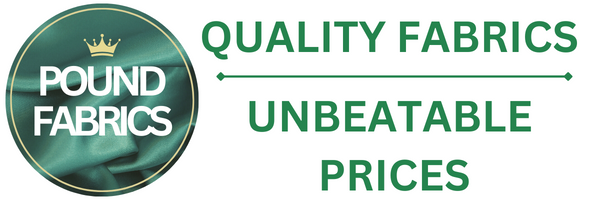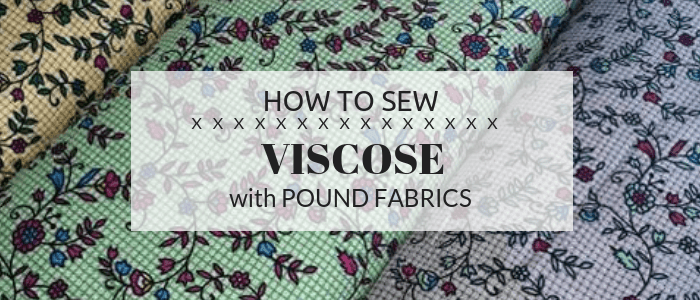
Viscose is notorious for being a slippery customer - but that doesn't mean you have to avoid it! Viscose is a great alternative to expensive silky fabrics with the same great drape and luxurious shine,so you definitely shouldn't overlook it when choosing fabrics for your next make! This guide is designed to help make sewing viscose easier, so that you needn't splurge on expensive fabrics if you're on a budget and sew with viscose instead.
Origins of viscose:
Viscose, or rayon as it is known in some countries, was originally designed to be an artificial alternative to silk. People wanted a fabric with the same luxurious qualities as silk, but with a more realistic price tag. The invention of viscose was a little less glamorous, however, when a Swiss chemist, Georges Audemars, discovered how to make cellulose nitrate in 1855 - which would later be developed by manufacturers into the fibers that are woven to make viscose/rayon today. The name viscose is given due to the manufacturing process of Rayon, of which there are two types. The 'wet', 'runny' or 'viscose' method is most popular, hence the name!
How is viscose made?
Viscose is actually classed as neither a man-made or natural fabric, so it may be surprising that it is actually made from a basic form of wood pulp! The wood pulp is generally harvested from pine, spruce or hemlock trees, as wood chips. Let's get our goggles and lab coats on and discover the process of making Viscose fibre…
First, the wood chips are treated to make sheets of purified cellulose, which look like sheets of paper, and are then soaked in sodium hydroxide, or 'caustic soda'. This breaks down the sheets into fluffy white pieces of cellulose, which are then aged for several days.
Another chemical, liquid carbon disulphide, is then added to the fluffy crumbs which chemically alter them into cellulose xanthate. This changes their appearance too, from white pieces to light orange. These are then dissolved into a solution of caustic soda, which results in the thick viscose solution that gives viscose/rayon its name. This solution actually looks and feels a lot like honey - although we doubt it would taste like it! This solution is then aged again, filtered and vacuum treated to remove any bits and air bubbles which would cause any fibre filament to be weak and break.
Once filtered, the solution is forced through a spinneret (a device which spins a fiber, like a spider spins a web) and into a sulphuric acid bath, which produces pure cellulose filaments. Depending on how big you want the resulting fiber to be, spinnerets with different sized holes may be used. The filaments can now be spun into a yarn ready for viscose/rayon fabric production.
How do you sew viscose?
You will need:
- Viscose Fabric
- Thread –opt for a Polyester blend, as this fabric is defined as neither natural nor man-made
- Dressmaking Scissors
- Sharp Straight Pins
- Sharps Hand Sewing Needles
- Sharps Machine Needle or Sharp Ballpoint Machine Needle
Cutting Viscose:
When cutting viscose, be sure to use a sharp cutting tool. As viscose is extremely slippery, we recommend using a sharp rotary cutter and mat. If you don't have a rotary cutter, you may use sharp dressmaking scissors however be sure to lay the Viscose out smoothly on a flat surface. You will want to use a lot of pins and pattern weights, or a combination of both, as viscose is so prone to moving around. Using both methods will ensure you get an accurate cut.
Stitching Viscose:
Viscose is actually relatively simple to sew with if you use the right sized needle, but make sure you pin and cut everything accurately. To sew on a machine, ideally used a Sharps Machine needle (around a size 70/10) or a fine Extra Sharp Ballpoint Machine needle (in a size 75/11). These needles are both fine and sharp and won't get caught in the fabric. You can also use a sharp, new Universal needle if you have no others to hand.
When hand-sewing or tacking, use regular sharps needles. If your needle is not penetrating the viscose easily, replace it with a fresh, sharp needle.
Thread selection should either be a 100% polyester thread or a polyester blended thread. This is because viscose is neither a natural nor man-made fiber, so to best match the fabric composition and feel, go for a blended composition thread. This will ensure that the fabric and thread share similar properties, making for easier garment aftercare.
You do not need a special sewing machine foot to sew viscose, but it can be difficult to feed two layers of this slippery fabric through the machine at the same time. If you want extra help, try using a walking foot and lots of pins (although don't sew over them!) to keep the layers together evenly.
Use a regular stitch length to sew your viscose, but as always, be sure to try a variety of stitches for your individual fabric as this may vary!
Finishing Viscose:
Cut edges of Viscose and any seam will continue to unravel and fray if left unfinished, with wash and wear. The best way to finish your seams is to overlock them, but if you don't have your own overlocker or serger, you can use a simple zig-zag stitch on your machine to reduce the amount of fraying.
To hem your fabric, use a simple single fold, blind hem, as this is the least bulky. This type of hem will also allow the free movement and flowing of your Viscose, as this is one of its best properties, and you don't want to lose this.
Extra tips:
⇒ Pre-wash your fabric - Viscose is notorious for shrinking after washing, so be sure to pre-wash, dry and press your Viscose before you sew your garment. This will avoid shrinkage and mis-shaping after construction.
⇒ Use lightweight interfacing - If you are interfacing your project (Viscose is quite drapey so you may need to interface it!) be sure to use a fine, lightweight option. Ideally, iron on your interfacing before cutting your pattern pieces, as this will allow a more accurate cut and actually make it easier to do so.
⇒ Use pins and weights - Using a combination of pins and weights when cutting and matching seams allows for the most accurate cutting and sewing. Using both will mean the process takes a little longer, but you'll end up with a really professional result.
⇒ Finish any raw edges - Viscose frays a lot, so be sure to appropriately finish all edges and seams, otherwise you risk your garment falling apart!
So, don't wait any longer - you have no excuse to not utilise this practical and beautiful fabric in your sewing!
To see our full range of viscose fabrics, please click here.
Make sure to tag us @poundfabrics and show us your creations on Instagram, Facebook and Twitter!
Copyright © 2019 Pound Fabrics. All Rights Reserved











Sheelagh
January 14, 2025
Thank you, very helpful and I have been sewing for year, a nice reminder xx